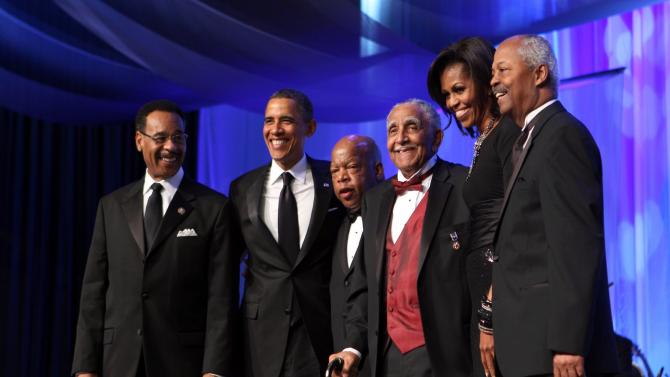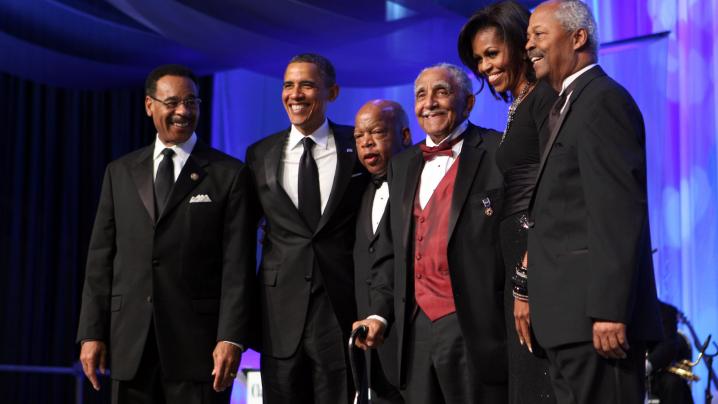[ad_1]

President Barack Obama (second from left) pictured at a Congressional Black Caucus event dinner in Washington, D.C., Sept. 24, 2011, where the president admonished the CBC to “stop complaining.” Pictured with Obama are (from left) Rep. Emanuel Cleaver II (D-Mo.), Rep. John Lewis (D-Ga.), the Rev. Joseph Lowery, first lady Michelle Obama and Rep. Donald Payne (D-N.J.).
Chris Kleponis-Pool/Getty Images
The shade that one Black Lives Matter activist threw President Barack Obama Thursday while declining an invitation to a White House Black History Month event only seemed surprising to those not paying attention.
During both of Obama’s terms, and even before, a visible minority of black activists—some prominent, some not, and from different age groups—have criticized their president out loud when they felt their community slighted. They have been, and still are, disappointed because, they say, most of what they have gotten from him is shallow symbolism while other constituency groups have gotten attention to specific, targeted policies. It seems like a long time ago since those days in 2008 when Barack Obama represented so much to so many, particularly those in the black, sometimes radicalized, grassroots: a new black history was visible, with new opportunities and new freedoms possible.
Eight years later, the experiment in black American democracy is almost finished, and black authors have come forth to discuss Obama and his often-overlooked-by-him constituency. The books are: The Black Presidency: Barack Obama and the Politics of Race in America by Michael Eric Dyson; Fracture: Barack Obama, the Clintons and the Racial Divide by Joy-Ann Reid, national correspondent for MSNBC; and Democracy in Black: How Race Still Enslaves the American Soul by Princeton professor Eddie S. Glaude Jr.
These fine, very well-written and thought-out books dissect Obama from a decidedly black perspective, analyzing his complicated relationship to his identity as a black president. Glaude’s book takes it a step further, and forecasts what the open-source leadership of post-Obama America is going to look like. These works make it plain: Barack Obama is a man knowingly trapped within white supremacy’s borders, who has had to purposely create false equivalencies of white systemic racism against blacks and white people’s grievances over the idea that other groups are getting ahead of them.
In these books, Obama is a sincere manipulator of black style, substance and history who uses his personal story as a template to create a new America. His new America, however, comes at the expense of unpopular black history and reality. He has what Reid calls “competing inner visions.” He is fought at every turn by institutional racists in the Congress and blatant racists outside of it, and a fearful white public that, as Claude postulates, purposely “disremembers” what it wants to forget. Meanwhile, the scared whites see the black planet coming.
All the black racial markers of the Obama administration are explored, including: his “race speech” explaining Jeremiah Wright, his controversial pastor; Obama’s comments on the Henry Louis Gates Jr. arrest; the fatal shooting of Trayvon Martin; his remarks at the 50th anniversary of the March on Washington; and, perhaps most importantly, his “sermon” at the eulogy of the Rev. Clementa Pinckney, the preacher and state senator who was killed in last year’s Charleston, S.C., church massacre.
All these incidents and more are dissected and diagrammed in great detail. Reid details the arguments that Obama caused within black America’s intellectual, media and leadership circles (think: Tavis Smiley vs. Tom Joyner, or Cornel West vs. everybody but Tavis), giving us a needed, and well-told, chronology of how a black president split apart black liberals and leftist activists, people who used to see each other as comrades and friends.
(Dyson and Reid paint Obama’s first U.S. attorney general, Eric Holder, as a hero in the Obama presidency, as the kind of unapologetically black, outspoken government official who Obama, as president, can’t mimic. But Holder tells Dyson that if he and his boss had, by an act of fate, attained reversed positions, Americans would have seen a public Obama similar to Holder’s persona, and vice versa.)
The writers are sympathetic to Obama, particularly Dyson, although that doesn’t stop him and Glaude from jumping on Obama with both intellectual boots. Glaude refers to Obama as part of a Democratic Party snake oil “confidence man” tradition started by Jimmy Carter and Bill Clinton. At one point, Dyson charges that this “crossover messiah,” a man who combines the qualities of the visionary Abraham Lincoln and the retrograde Bill Cosby when he talks about race and who is “rooted in, but not defined by” black America, committed an act of “disloyalty” to the black struggle when he told the Congressional Black Caucus to “stop complaining” in a now-infamous 2011 speech. (Dyson correctly argues that Obama never scolded, say, white female students about sexism at Barnard College that way.) However, Dyson fights to redeem his subject at his book’s intellectually dramatic close.
This sympathy that the trio shows may have something to do with the fact that their situations mirror his own. All three writers are Ivy-degreed and are working at the top echelon of their “white” fields. It’s perhaps why their collective analysis purposely ignores, or radically downplays, the black radical traditions and their struggles against an illegitimate structure called America; looking at the 21st century through that lens would make them judge themselves, and Obama, too harshly. So Obama is as legitimate as America and its systems.
These works made me realize how important the academic books of now-ancestors Ronald W. Walters and Manning Marable were; they analyzed black political development from the ideological perspective of leftist black/African 20th-century political struggles—perspectives that would not overly excite cable-television-network program bookers.
This is why Reid, for example, can get away with describing the National Black Political Convention of 1972, one of the most important political strategy sessions for black activists and elected officials in the latter half of the 20th century, as a momentary, empty “thrill.” In (black political) reality, that convention produced a document—a template, actually—that black politicians and activists used throughout the 1970s, but that’s too outside of the mainstream for MSNBC’s Reid. On balance, though, she does give insight on the little-discussed and contentious relationship between that convention and Shirley Chisolm, a black woman who ran for the Democratic presidential nomination in 1972. A young outsider who supported her was named Al Sharpton, who, approximately four decades later, would become a confidant of Obama’s.
So the authors, working within their 21st-century, liberal, American, ideological self-restraints, producing works for popular consumption, mirror their subject’s tension. Glaude briefly discusses black radical political history, and comes close to a radical framework for his ideas when he advocates for new young grassroots leadership to replace what he argues is the soon-to-be-outdated “head Negro in charge” model. But the only new world these writers envision in 2016 and beyond is one where, as Dyson repeatedly says, black America has placed Obama just under Martin Luther King in historical importance.
Dyson, Reid and Glaude have accepted Barack Obama for what he is as Obama has accepted that he will never have the freedom of King, Malcolm X, George Jackson, Huey Newton, Angela Davis or Kathleen Cleaver. And that’s clearly fine with him. He traded any intellectual or cultural freedom for practical, patriotic power decades ago. That compromise might be in his DNA, a prepaid, permanent season ticket of sorts.
For the rest of black America—and particularly black South Carolina, as it decides whether it will fight the power with Sanders or accept incremental change with Clinton—it remains an individual and, ultimately, collective decision to pick up the white crayon, determined to never color outside the lines. Or to toss it down, get up and walk away. These books are important and recommended, because they will be among those that at least start that black intellectual discussion at the dawning of the post-Obama era.
[ad_2]






















